Revelation
II. Dating: late 80's through early 90's CE.
Overview
We cannot easily date the book of Revelation based upon its apocalyptic and prophetic language of symbols. It does give us hints, however. But before we focus on the date, we should inquire into the modern means of interpretation, the person of the author and the culture in which he wrote, then drill down to answer the question of time frame.
A. Three Means of Interpretation
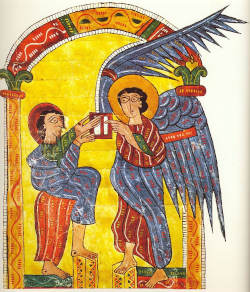
The Angel gives St. John
the Book of Revelation
There are three major types of interpretation for the book of Revelation: the preterist, the idealist and the futurist. Preterist (from the Latin "praeteritus" meaning "gone by") interpretation analyzes the book through the lens of history. It asks the question: What did the book mean to its author and his audience? In other words, late first century Christians applied the apocalyptic and prophetic symbols in the text to immediate their context. Preterist interpretation seeks to understand that context and how these believers applied the book to their lives. This way of reading the text rose to prominence in the nineteenth century with the emergence of the historical-critical method.
Idealist interpretation employs allegory to tease out meanings for the reader. It plucks out a particular phrase or image and applies a general insight to those details. In other words, the particular takes on a universal meaning. No longer do we ask: What does the book mean to the people immediately involved when the book came to light? Instead, we ask: What does the text mean to me? The timely gives way to the timeless.
Notice the two questions asked. The preterist focuses upon matters of the past. The idealist zeroes in on the needs of the present. The tendencies of each need balance. A strict preterist interpretation leaves study of the text sterile, even void of personal investment. Viewing the book through an idealist lens can lead to fanciful, even other worldly interpretation. How do we keep the original meaning in view and still maintain its relevance? First, ask what the text mean to the faithful in the first century. With that insight in mind, then ask what it means to us today.
The futurist (or dispensational) reading of the book seeks to project Revelation's symbolic language into upcoming events. It does not envision the book as a historical work but as a product of shear prophecy, a prediction of the future. Here it limits prophecy not to the biblical notion of the prophet as the conscience of the faithful and as the messenger of divine will, but as the seer of oncoming tragedy. It has the shortcoming of literal speculation; by identifying a particular person or event with a symbol in the book, its practitioners fall prey to constant revision and, so, ridicule by its critics.
Gentle reader, you may have noticed I employ the historical-critical method, hence I'm a preterist. I will also mention other means of interpretation such as liturgical outlook. I hold to the importance of the original context, especially in the question of dating the text. After all, that inquiry is historical in nature.
So, to see how the author's fanciful visions made sense to early Christians, we must investigate how he addressed them in a way that resonated with his audience's common cultural experience.
B. Background: Author and Context
1. Authorship: Who was John?
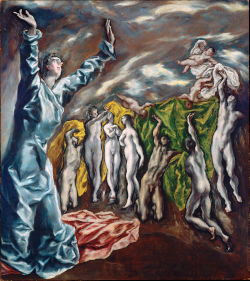
Vision of St. John
by El Greco
The author of Revelation named himself "John." This self identification marked Revelation as different from any other apocalyptic book, either past or contemporary. Other such writings relied on pseudonyms to claim some legitimacy with their audiences. But, Revelation stood apart based upon the reputation of the author. John composed the book in a medium that gave it legitimacy (at the time, the populace prized writing over oral transmission). He also exercised authority over churches in Asia Minor to which it was addressed. And that power he claimed, plus the unique nature of the book, helped secure its place in Christian tradition.
John was a Jewish Christian. He referenced the prophets from the Hebrew Scriptures, especially Ezekiel and Isaiah. He alluded to images themes found in other apocalyptic books such as the Enochic literature. He penned his book as a prophet, just like the works that inspired him. While he focused on Christian concerns, he drew from a greater Jewish culture on an intimate level.
Was the author John the Apostle? Against tradition, most scholars answer "No" for several reasons. First, the author did not identify himself as one "sent" by Christ, nor did he even claim to have personally known Jesus.
Second, while his composition does share a few theological themes (the divinity of Christ and the Savior himself as the slain Lamb), it does not match the writing style or the world view of the Fourth Gospel. John's Gospel envisioned the world in positive need of enlightenment; the Evangelist elevated his Savior to the level of a placid, even-handed Christos Pantocrator (see John 3:16-18). Revelation gazed upon the social order in the negative light of condemnation; John of Patmos saw the slain Lamb Messiah on the right hand of a God who meted out harsh judgment on an immoral, polytheistic society.
Third, his imprisonment on the isle of Patmos indicated he made his faith public knowledge even to the point of agitation (Rev 1:9). Yet, this punishment simply consisted of exile, not to the traditional cave with its chains currently found in the monastery on the island. Instead, officials would banish one accused of magic, astrology or any even minor threat to political order in order to live out their existence on the meager resources of such an island. To back this last point up, archaeologists have led expeditions on Patmos and found a typical Aegean village with its amenities, but without any penal facilities. So, the legend of the Apostle in chains on island did not dovetail with the facts as scholars knew them.
To sum up, John of Patmos was an apocalyptic Jewish Christian of some renowned in Asia Minor, both within the churches as a prophet and outside with local pagans as an agitating critic. Due to his reputation, officials banished him to the Aegean isle off the coast of modern day Turkey. From this small landmass, he wrote Revelation.
2. Historical Context
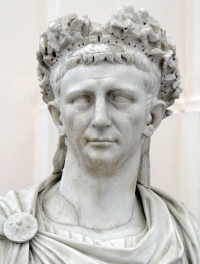
Claudius (r 41-54)
The sunset of the Apostolic era and the dawning of post-Apostolic times marked a significant shift in public perceptions about Christians. According to Suetonius (69-122 CE), the emperor Claudius expelled a "Chrestos" who fought with Jews in the city (ca 49 CE; Claudius 25); he further described punishment inflected upon Christians "a class of people given to a new and mischievous superstition" (Nero 16). According to Tacitus (56-124 CE), Nero shift the blame for the great fire in the Eternal City (19-27 July 64 CE) upon the followers of the Christ (Annals 15:44). While some scholars dispute the meaning and reliability of these references, they do acknowledge a rise negative perceptions about the new faith.
At some point in this time frame, Christians and Jews began to grow apart. While they shared monotheistic roots and, in some cases, apocalyptic outlooks, they differed in realization of the later. Christians held the Kingdom would come through Jesus of Nazareth, especially in his salvific death and resurrection. Most Jews rejected this view. However, another obstacle arose on the scene: the teachings of St. Paul who proposed an equality between Jews and Gentile based upon a Christian faith that superseded duties imposed by the Law (see Eph 2:8-10). With the destruction of the Temple in 70 CE, Jews increasing looked to the Pharisees and their emphasis on duty to the Law. Meanwhile, Christians turned towards Gentiles, focusing upon a right relationship with God through Christ. With the widening split between the two factions (both ethnically and theologically) came mutual animosity.
Early Christians faced prejudice and, in some cases, persecution. Pagans, heavily influenced by imperial perceptions, grew suspicious of faith as a new phenomena, distinct from Judaism. Jews placed the faithful at arms length because of the difference outlined above. As a result, the Christians felt ostracized and soon developed a "bunker" mentality.
Of course, these divisions and attitudes developed over time. However, at what point along this span did John pen Revelation, sooner or later in the first century CE? Now we can turn to the question of dating the text.
C. Dating Revelation
1. John's temporal perspective
Two verses addressed the temporal perspective of John's visions:
"Write therefore the things which you have seen, and the things which are, and the things which will happen hereafter." (1:19)
This was a parallel to the description of God ("he who is and he who was and he who is to come" Rev 1:4).
"Come up here, and I will show you the things which must happen after this." (4:1)
A heavenly voice invited John to ascend into the divine throne room. Note the perspective on temporal events ("things that must happen after this") depended upon what God saw, not on human sight. John peered through the divine eyes of "he who is, he who was and he who is to come." In other words, the author did not detail future events in a linear fashion that would fit a compact narrative. So, we must address Revelation as a composition in the apocalyptic genre that employed techniques common in the first century CE (chiasmus, parallel construction, cyclical loops, etc.) and attempted to see history through a transcendent view where past and future mixed into the present.
2. John's quest for apocalyptic signs
Like many other Christians of the first century CE, John believed he lived in the end times. He stood as a witness to the final days so he looked for apocalyptic signs, natural, social and political. Unlike we moderns with our compartmentalized explanations for the world, he envisioned reality through a single lens combining religion, culture and politics. Like his contemporaries, he held everything and every event found its cause in the spiritual dimension; anything that happened was the result of spirit activity for good or ill. For John, both natural and socio-political events had apocalyptic significance.
a. Natural events
1) Volcanic activity
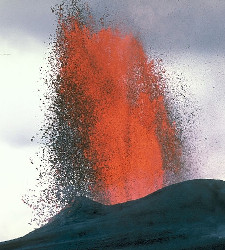
Volcanic Eruption
Hawaii, 1983
The Mediterranean basin lies along the stress line where the Eurasian and northern-moving African tectonic plates meet. The convergence of these plates gave rise to 11 volcanic fields in Greece, 38 fields in Italy, 9 fields in Anatolia and 18 in Western Europe. Magma movement caused seismic activity in the area; so, ancient peoples along the Mediterranean had a cultural knowledge of both volcanoes and earthquakes.
The two most important eruptions were Thera eruption in the mid-second millennium BCE and the explosion of Mt. Vesuvius in 79 CE. The Thera eruption stood one of the greatest volcanic explosions in history, creating a crater below sea level and destroying the Minoan culture in the Aegean basin. The eruption of Mt. Vesuvius in 79 CE destroyed Herculaneum and entombed Pompeii.
The volcanic ash cloud that formed from an eruption consisted of rock, mineral or glass fragments up to 1/12 inch in size. The onrush of such a cloud could cause large scale destruction like the Mount St. Helen explosion in 1980 that melted several glaciers on the mountain and stripped away forests for several miles.
Rev 9:1-12 described an event comparable to a volcanic eruption and the resulting ash cloud. The onrush of fragments would sting but not kill people on the outer edge of the cloud. Since John saw nature phenomena caused by spirits, he named the leader of the fragment "locusts" as "Apollyon," a clear reference to the Greek sun god. The emperor Domitian (ruled 81-96 CE) fancied himself as an Apollo-like figure.
2) Earthquakes

Earthquake Destruction
Haiti, 2010
The stress between the two continental plates caused frequent earth tremors. The first century CE marked several memorable earthquakes:
Philadelphia (Rev 3:7-13) along with 12 other cities in Asia Minor suffered from devastating earthquake in 17 CE. Tacitus (56-120 CE) and Pliny the Elder (23-79 CE) reported on this night-time tremor.
Laodicea (Rev 3:14-22) suffered from an earthquake in 60 CE.
Pompeii suffered from a quake in 62 CE. Herculaneum and Nucera incurred severe damage. Seneca the Younger (4 BCE – 65 CE) described this tremor in his Quaestiones Naturales VI.
b. Socio-political events
John painted images that shared a close relation to social attitudes, political realities and events of his times.
1) The Four Horsemen of the Apocalypse (6:1-8)
The white horse represented the victorious Parthians with their bowmen calvary (Rev 6:2). The blood red horse reflected strife within the Empire (Great Jewish War 66-70 CE) and Roman civil war (Year of Four Emperors 69 CE; Rev 6:3-4). The black horse inferred growing tension with Diaspora Jews might have caused disruption in grain supplies from Egypt and Palestine in the late first century CE (Rev 6:5-6). The pale green horse was suffering from death and devastation in Palestine after the Great Jewish War (66-70 CE; Rev 6:7-8).
2) Measuring the Temple and the Two Witnesses (11:1-14)
In chapter eleven, John was given duty to chastise the communities which represented God's Temple (measure the inner court; Rev 11:1) but Rome laid waste to Jerusalem in 70 CE ("tread the holy city under foot"; Rev 11:2). The two prophets in Rev 11:3-4 represented the witness of the Hebrew Scriptures (personified in Moses for the Law and Elijah for the "Prophets"). The death of these two symbolized the lack of authentic witness in the city by the local church and, in a greater sense, the destruction of the holy city (Rev 11:7-9). The joyful reaction of the pagans (Rev 11:10) echoed the victory parade for Titus' campaign against Jerusalem (see Spoils of Jerusalem fresco on the Arch of Titus erected by Domitian in 81 CE).
3) The Two Beasts (13:1-18)
Chapter 13 introduced hints in the form of the two beasts. The first beast that rose from the sea represented the Rome (and the Empire) with its pagan gods ("on his heads, blasphemous names"; Rev 13:1) and military might (speed of a leopard, presence like a bear's footprint, roar like a lion); its reach and power, along with its resulting hubris (Rev 13:4), could only find its root in evil ("the Dragon"; Rev 13:2). Again, notice it revived after a wrenching series of civil wars in the Year of Four Emperors, 69 CE (fatal head wound; Rev 13:3). With the ascent of Vespasian to the throne, it reasserted domination over many nations (Rev 13:7), thus demanding tribute and a recognition of the Roman order as a result of divine will (offering to the bust of the emperor in Rev 13:12; Rev 13:8).
The second beast mirrored the Nero Redivivus myth, that the evil emperor would rise up after his death in 68 CE to reclaim the throne. Note the two opposing but parallel images. John presented the slain and resurrected Lamb as the world's Savior (Rev 5:8-14). Yet, the second beast rose from the earth with the horns of a lamb like Christ but would speak the evil of the dragon (Rev 13:11). He would mimic the powers of the Lamb (calling fire from the sky, see 1 Kings 18:38, 2 Kings 1:10, Rev 11:5; Rev 13:13-14). His power would reach even within the economy, only allowing commerce with the use of coins displaying an engraved image of the emperor ("mark of the beast"; Rev 13:16-17). Assigning numerical value to letters (A = 1, B = 2, etc.), the number of the beast, 666, translated to "Nero Emperor" (Rev 13:18). In 90 CE, such a Nero figure appeared with the backing of the Parthians.
4) The Whore of Babylon (17:1-18) and her Downfall (18:6-19)
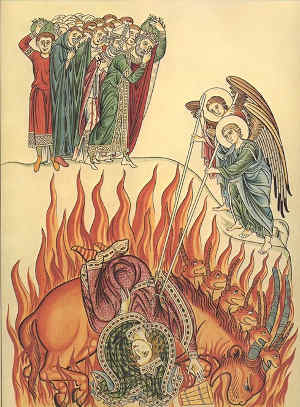
Fall of
the Whore of Babylon
In chapter 17, Romans saw their wealth and power symbolized by the patron goddess of the Imperial City, Dea Roma, ("woman dressed purple and scarlet, bedecked in gold, precious stones and pearls"; Rev 17:4). They presided over a polytheistic culture ("...woman sitting on a scarlet-colored beast full of blasphemous names..."; Rev 17:3) that isolated, even persecuted Christians ("the woman drunk on the blood of the saints"; Rev 17:6). One source of Roman hegemony was its inclusion of foreign gods into the worship of average pagans; Jewish Christians equated such cult ("idolatry") as sexual immorality (Rev 17:2, Rev 17:5).
As noted above, the beast upon which the woman rode was Rome and, be extension, the Empire. Note for a third time that the socio-political order convulsed from civil wars during the Year of the Four Emperors yet revived ("the beast that was, and is not, and shall be present"; Rev 17:8, Rev 17:11). John referred to the famous seven hills of the city ("the seven heads are the seven mountains on which the woman sits"; Rev 17:9), then equated those hills with a line of seven emperors, the last of which (the second beast; Rev 17:11) would lead the evil ("ten" vassal powers; Rev 17:12-13) in the final battle against divine forces (Rev 17:14). Notice the vassal powers around the Mediterranean basin (Rev 17:15) desired nothing less that an overthrow of vast Roman rule (Rev 17:16) yet cooperated under its influence (17:17).
The imperial city ruled over the Empire through direct rule, alliances and protectorates; in the last two cases, vassal kings and regents kept local order while Rome maintained peace and security. Rev 18:3 and Rev 18:11-13 pointed to the "merchants of the earth grew rich from the abundance of (the whore's) luxury." Here, roads built and sea lanes established for the quick movement of imperial troops created the grid work for free trade and the accompanying economic prosperity that followed; the infrastructure that resulted in pax Roma also enabled prosperity.
Rev 17:2, Rev 18:3 and Rev 19:2 named the whore as the universal corrupter of morals. No doubt, the imperial system encouraged graft in taxation and imperial preferences for some over others, but Rome itself, according to the author, corrupted the general populace with the promotion of polytheism and prejudice against Christians; such ill feelings did occasionally break out into mob violence, even murder. The predicted destruction of Rome, along with its hegemony, would cause rejoicing in some quarters (Rev 19:1-4)
3. An aside: Is Babylon Rome or Jerusalem?
How can we confidently hold John associated Babylon with Rome and not Jerusalem, as some assert? Consider the place of Babylon in the popular imagination of first century Jews. It represented a place of exile where they lived a marginalized existence (Psa 137). It also symbolized an exotic culture of polytheism. During the first century CE, Jerusalem did not fit the Babylonian mold in either way. Yes, the ancient prophets condemned the fickle leadership of Jerusalem with its shifting alliances between Egypt and powers in the East (Isa 1:21, Jer 2:20, Jer 3:1–11, Eze 16:1–43, Ezekiel 23). And, true, a few Judean kings worshiped foreign deities (2 Kings 21:1-7) and placed idols in the Temple (Eze 8:1-18). Yet, no biblical text equated Jerusalem with Babylon. Any condemnation of the pagan bastion by the prophets merely foreshadowed the fall of the city to the Cyrus and the Persians (Isa. 13:1-14:27, Isa. 47:1-3; Jer. 50:1-3, Jer. 51:1-4). In addition, Jerusalem suffered under Roman corruption during the 50's and early 60's CE. During the Great Jewish Wars (66-70 CE), the city fell to the chaotic infighting of competing warlord gangs (see Josephus, "War of the Jews," Books IV-VI). These realities did not mesh well with the popular notion for Babylon. For John, Roman rule felt like the worst of both symbols: anti-semitic, anti-Christian social attitudes and the universal prevalence of polytheism. Rome fit the oppressive image of Babylon in ways that Jerusalem did not.
D. Conclusion
As we pull together the threads of evidence John presented, we can see the picture of John as an apocalyptic prophet. As a vocal critic of Rome and her hegemony, the author wrote to an audience that increasingly faced prejudice, social rejection and, at moments, bloody persecution from pagan culture at large. He painted word images that hinted at natural catastrophe (earthquakes and eruption of Mt. Vesuvius), along with socio-political upheaval (Year of the Four Emperors, the end of the Great Jewish Wars, the Parthian threat and the Nero Redivivus myth). John did not merely predict the end times, he, along with his audience, firmly held they were experiencing it.
So, taking all the evidence into account, John most likely wrote Revelation during the rein of Domitian, in the late 80's through early 90's CE.
Photo Attributions
Vision of St. John. El Greco [Public domain]
Eruption on Hawaii, 1983. J.D. Griggs [Public domain]
Fall of the Whore of Babylon. Herrad of Landsberg [Public domain]
The Angel and John. Real Biblioteca de San Lorenzo [Public domain]
Bust of Claudius. Naples National Archaeological Museum [CC BY 2.5 (https://creativecommons.org/licenses/by/2.5)]
